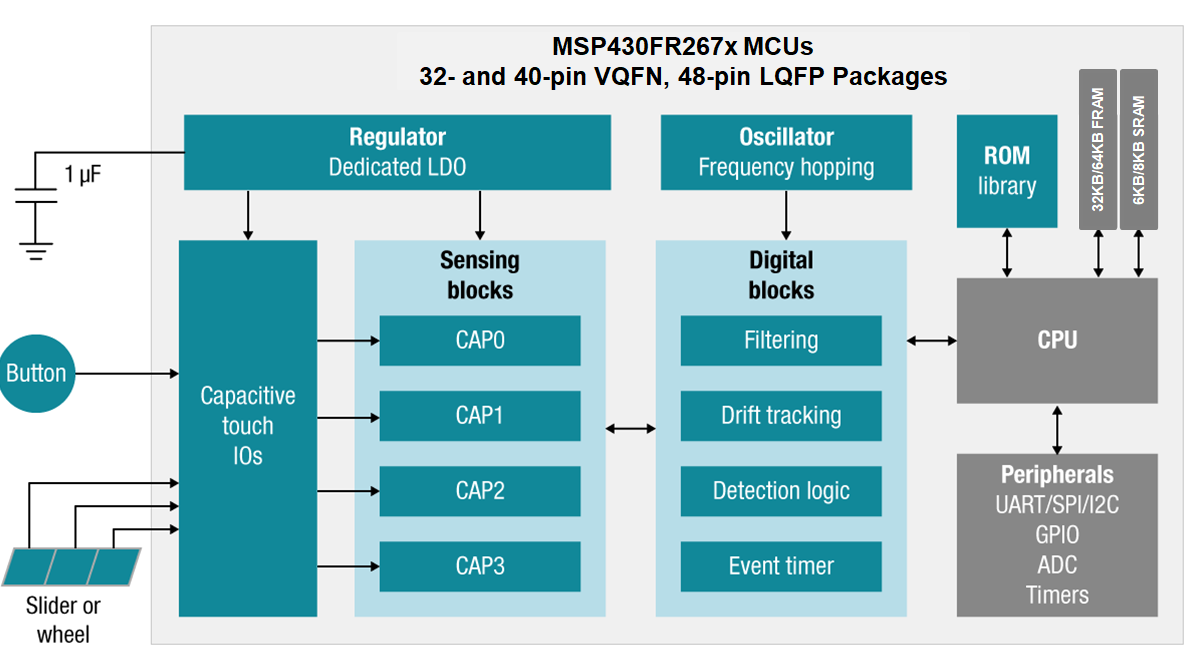SSZT504 april 2019 MSP430FR2633 , MSP430FR2675 , MSP430FR2676

Industrial designs are evolving faster than ever to deliver sleek and reliable human-machine interfaces (HMI), especially in major appliances and building security systems. Mechanical buttons and knobs are making way for capacitive touch, and TI’s CapTIvate™ capacitive touch sensing microcontrollers (MCU) are leading the way in this user experience revolution.
The new MSP430FR2675 and MSP430FR2676 devices will help scale your designs with capacitive touch while reducing costs, design time and board space. Here’s a quick rundown of the benefits of CapTIvate, particularly these two new devices:
- Ease of use: Saves time and helps you get to market faster through an expansive suite of tools and resources – start your design in less than 5 minutes.
-
Versatility: Offers design flexibility with full configurability from self- and mutual-capacitance sensors and comprehensive libraries for buttons, sliders, wheels and proximity sensing.
-
Lowest power: Detects touch autonomously without CPU intervention and ensure a long battery life.
-
Robustness and reliability: Avoids false touch detects and achieve superior reliability with IEC- and IPX-certified solutions for conducted noise and moisture tolerance.
 Figure 1 MSP430FR267x MCUs Block
Diagram
Figure 1 MSP430FR267x MCUs Block
DiagramAs you’ll see in Figure 1, the MSP430FR2675 and MSP430FR2676 offer 32KB and 64KB of non-volatile memory, giving you more code space for running your application code or storing/logging data. Higher pin-count packages (including a 32-pin VQFN, a 40-pin LQFP, and 48-pin LQFP) give ample serial communications ports and GPIOs for interfacing with other system components. If you want to interface with analog sensors, the integrated 12-bit ADC has you covered. Why rely on a two-chip host MCU + discrete capacitive touch MCU solution? With these devices, designers can leverage the additional memory, pins, and analog to deliver a single-chip solution, thereby saving BOM cost and board space.
These devices are also certified for extended temperature ranges up to 105C – a key requirement for designers within the Appliances market. Furthermore, several noise-immunity post-processing techniques like multi-frequency scanning and oversampling are automated in the CapTIvate IP, enabling a more robust capacitive touch. With these combinations of features, the MSP430FR2675 and MSP430FR2676 are ready to serve as the main system controller in your application.
Portfolio scalability and ecosystem
 Figure 2 CapTIvate MCU Portfolio
Figure 2 CapTIvate MCU PortfolioProject requirements can change over time, and features may need to be added or removed on the fly. If you want to future-proof your design, you need an MCU family that scales with your requirements.
With the MSP430FR2633 and the introduction of the MSP430FR2675 and MSP430FR2676, CapTIvate now offers pin-to-pin compatible solutions for 16KB, 32KB, and 64KB MCUs in a 32-pin quad flat no-lead (QFN) package (see Figure 2) so changing requirements no longer means restarting your design from scratch.
Explore how these new devices can revolutionize your HMI by pushing the limits of capacitive touch and serving as your main system MCU. Purchase samples of the MSP430FR2675 and MSP430FR2676 microcontrollers today.
Additional Resources:
- Check out additional sensor boards, MCU boards and programmer boards.
-
Start tuning your sensors in 5 minutes or less in the CapTIvate Design Center – your one-stop resource for everything related to CapTIvate capacitive sensing technology.